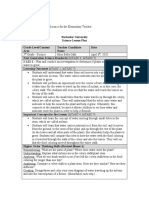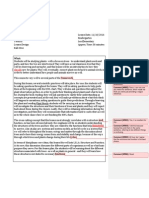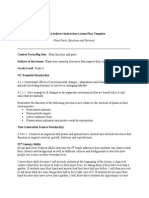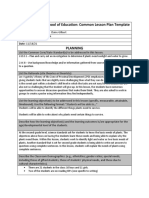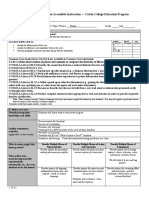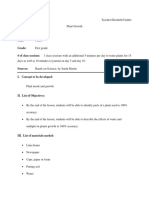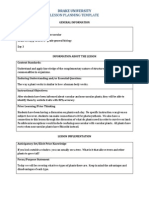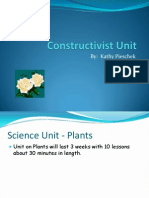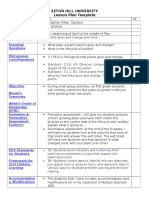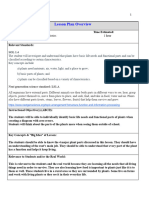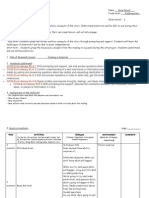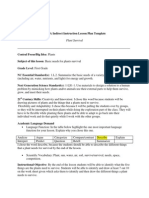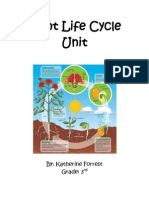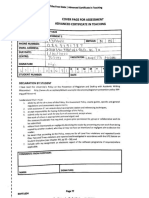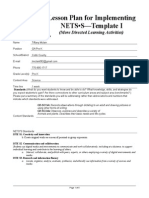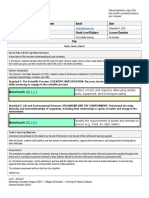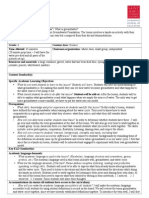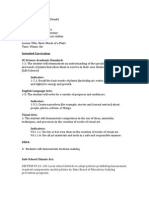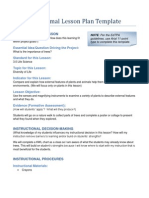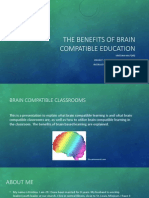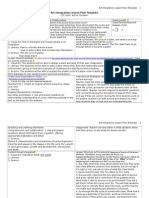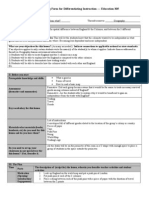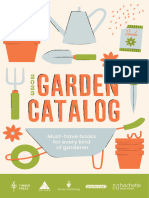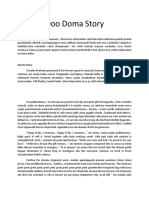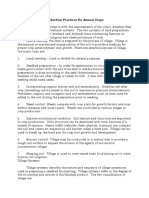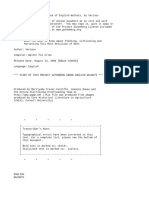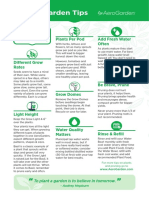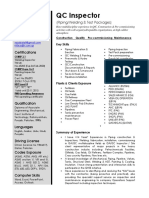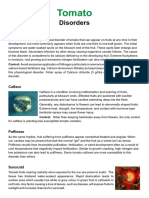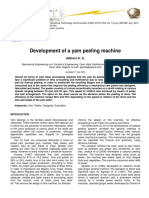Color Carnations
Color Carnations
Uploaded by
api-219914719Copyright:
Available Formats
Color Carnations
Color Carnations
Uploaded by
api-219914719Original Description:
Original Title
Copyright
Available Formats
Share this document
Did you find this document useful?
Is this content inappropriate?
Copyright:
Available Formats
Color Carnations
Color Carnations
Uploaded by
api-219914719Copyright:
Available Formats
Lesson Planning Form for Accessible Instruction Calvin College Education Program
Teacher Date Rebekah Kreischer March 25, 2013 Subject/ Topic/ Theme Science/Plants/ Stem Grade ___1_____________
I. Objectives How does this lesson connect to the unit plan?
This lesson will teach students about the anatomy of a plant
Learners will be able to:
Explain why stems are important Recall the anatomy of a plant
cognitiveR U Ap An E C*
physical development
socioemotional
u r
Common Core standards (or GLCEs if not available in Common Core) addressed:
L.OL.E.1 Life Requirements- Organisms have basic needs. Animals and plants need air, water, and food. Plants also require light. Plants and animals use food as a source of energy and as a source of building material for growth and repair. L.OL.E.2 Life Cycles- Plants and animals have life cycles. Both plants and animals begin life and develop into adults, reproduce, and eventually die. The details of this life cycle are different for different organisms. CCSS.ELA-Literacy.SL.1.1 Participate in collaborative conversations with diverse partners about grade 1 topics and texts with peers and adults in small and larger groups. CCSS.ELA-Literacy.SL.1.5 Add drawings or other visual displays to descriptions when appropriate to clarify ideas, thoughts, and feelings. (Note: Write as many as needed. Indicate taxonomy levels and connections to applicable national or state standards. If an objective applies to particular learners write the name(s) of the learner(s) to whom it applies.) *remember, understand, apply, analyze, evaluate, create
II. Before you start Identify prerequisite knowledge and skills.
What a flower is That all flowers look different
Pre-assessment (for learning):
KWL, story progress, journal facts Outline assessment activities (applicable to this lesson)
Formative (for learning): Formative (as learning):
Roll-a-plant, characteristics Summative (of learning):
Provide Multiple Means of Representation Provide options for perceptionmaking information perceptible Visual Hands-on Writing Activity Provide options for language, mathematical expressions, and symbols- clarify & connect language Provide Multiple Means of Action and Expression Provide options for physical actionincrease options for interaction Provide Multiple Means of Engagement Provide options for recruiting interest- choice, relevance, value, authenticity, minimize threats Create a flower Flower dissection
What barriers might this lesson present? What will it take neurodevelopmentally, experientially, emotionally, etc., for your students to do this lesson?
Provide options for expression and communication- increase medium of expression
Hands-on stem activity Flower anatomy activity
Drawing Writing Solo work
Provide options for sustaining effort and persistence- optimize challenge, collaboration, masteryoriented feedback
Giving predictions of what the flowers will look like after being in the colored water for 4 days
1-19-13
Provide options for comprehensionactivate, apply & highlight
2 activities Flower story
Provide options for executive functions- coordinate short & long term goals, monitor progress, and modify strategies
Provide options for self-regulationexpectations, personal skills and strategies, self-assessment & reflection
Story drawing
Story Flower activity
Materials-what materials (books, handouts, etc) do you need for this lesson and are they ready to use?
Carnations Food coloring Cups Water Roll-a-Plant handout The Tiny Seed Scissors for teacher Table groups
How will your classroom be set up for this lesson? III. The Plan Time 5 min 5 min Components Motivation (opening/ introduction/ engagement) Describe teacher activities AND student activities for each component of the lesson. Include important higher order thinking questions and/or prompts. Introduce the lesson: o We are going to read The Tiny Seed by Eric Carle again because I think he tells us some important things about stems o Read aloud The Tiny Seed Once called on students should respond o After reading ask so what by explaining the flowers got stepped on happened to the stems in the and picked so the stem broke. If the stem story that would cause the breaks then water cannot get to the flower flowers to die? o After explanation say You are right! And at that is what we will talk about today, stems! Introduce activity: o Group 1 will be at the table with me and we will explore more about stems and how important they are o Group 2 will be working on the last two pages of our seed stories o Group 3 will be working on another game! Proceed to explain the new roll-a-plant game. Group 1: o Once students are at the table ask them Why do you think the stem is so important for a flower? o Right, but what else? What do you think a flower would look like if it did not have a stem? Students should tell you that it carries water to the flower
1520min
Development (the largest component or main body of the lesson)
One student should respond saying that without the stem the blossom would not
1-19-13
15-20 min 15-20 min
You are so right! What we are going to do is see how far the stem takes the water in the flower. Look at this. I have cut open the stem of a carnation, do you see the veins? What do you think they do? After students have grasped that the veins bring the water to the petals as well explain the activity: Have students write their name on a piece of tape, stick it to the top of the flowers stem, and then place the flower in the colored water. Ask the students do you think that the whole petal will be the same color as the water or only part of it? Why? Once finished with the above activity give students a chance to check on their plant growth
be able to stand up straight. Students should look inside the stem and attempt to see the veins. Once the veins have been seen students will discuss with the teacher how the veins in a stem are similar to the veins that humans have.
Students will write their name on the piece of tape, stick it to the stem, and then place their flower in the colored water.
Each student should share their prediction
Students will get 1 minute to check their plant growth and ask questions Continue writing/illustrating story
Group 2: o Work on flower story with help from Mrs. Herceg Group 3: o Roll-a-plant Roll dice to determine traits of your plant Create a drawing of your plant Label the stem, petals, leaves, and roots Switch groups so that students are able to experience each station What do you think will happen to the carnation? What will it look like when we come to school tomorrow? Why do plants have stems?
Create plant based on characteristics
Once bell is rung students will quickly and quietly meet on the rug to switch groups based on teacher instructions
2 min 3 min
Closure (conclusion, culmination, wrap-up)
Share predictions.
Hold the plant up and bring water to the entire plant
1-19-13
5 min
Once they seem to have grasped the point of todays lesson explain whats next by saying We have learned so much about plants! I am going to bring back the KWL chart we filled out a long time ago and I want to know exactly, what have we learned? Which of your questions have we answered?
After this finish off by telling students Wow, I think we are all plant experts! Now I think we can take our flowers home and begin to use what we have learned to take care of them! I am very confident that our flowers will grow up big and strong just like all of you! Your reflection about the lesson, including evidence(s) of student learning and engagement, as well as ideas for improvement for next time. (Write this after teaching the lesson, if you had a chance to teach it. If you did not teach this lesson, focus on the process of preparing the lesson.) Today went so smoothly! I was confident going into the lesson and I anticipated the things that would eat up the most time in order to have a plan to initiate when it got to that point. My students were fairly rowdy because it is Friday and it is my last lesson. Unfortunately I did have to ask a student to clip down due to his acting out. I felt terrible for doing it but after that I had control of the two rowdy boys once again. Aside from a slightly rowdy bunch of students the lesson went great. My timing was pretty good. If I went over 20 minutes it was by no more than a couple of minutes which just made me so much more confident every time we switched groups. The students were talking only about what was happening at the small table which was amazing. When I explained that the veins in a stem are similar to the veins that humans have the students were able to grasp that the veins are what carry the water through the flower and the stem is like our skin and protects the veins inside. From there I asked my students if the veins stop where the petals stop or do they go into the flowers. I heard different answers and as soon as I explained the activity to test our ideas the students got so much more excited! They eagerly shared their predictions with a smile on their faces and a sparkle of curiosity in their eye. While they are upset the have to wait until Tuesday to take the flowers home, they reluctantly agreed to wait that long. If I did this lesson over again I think the only thing I would change is to color one of the flowers ahead of time so that the veins in the stem are more visible to my students. Other than that I believe the lesson went so well!
Students should raise their hands and as they are called on students should share something that they have learned through the unit such as not all plants need the same amount of sun or water but all plants need sun water and soil to survive, the stages of a plant cycle, plants have veins just like humans, etc. Students should also compare what we have learned to the questions in the W column of the KWL to see which questions have been answered.
1-19-13
You might also like
- 5e Lesson PlanDocument2 pages5e Lesson Planapi-276414713100% (2)
- Lesson Plan PhotosynthesisDocument5 pagesLesson Plan Photosynthesissmily_face15No ratings yet
- GSW Lesson Plan 2 Larsen Katlynn BennettDocument7 pagesGSW Lesson Plan 2 Larsen Katlynn Bennettapi-358813049No ratings yet
- Johnny Appleseed - Apple Life Cycle Lesson PlanDocument3 pagesJohnny Appleseed - Apple Life Cycle Lesson Planapi-267446628No ratings yet
- How The World Works-FinishedupDocument4 pagesHow The World Works-Finishedupapi-147600993100% (1)
- SciencelessonplanDocument7 pagesSciencelessonplanapi-450819181No ratings yet
- Appreciating The Text Class 4 GulmoharDocument12 pagesAppreciating The Text Class 4 GulmoharNidhi Kaushik100% (1)
- Seed StoryDocument4 pagesSeed Storyapi-219914719No ratings yet
- One SeedDocument3 pagesOne Seedapi-219914719No ratings yet
- Germination LessonDocument4 pagesGermination Lessonapi-219914719No ratings yet
- Lesson Planning Form For Accessible Instruction - Calvin College Education ProgramDocument4 pagesLesson Planning Form For Accessible Instruction - Calvin College Education Programapi-313893599No ratings yet
- Domain 3 Science LessonDocument2 pagesDomain 3 Science Lessonapi-277422113No ratings yet
- Flowers LessonDocument4 pagesFlowers Lessonapi-272624393No ratings yet
- Science DraftDocument6 pagesScience Draftapi-270516233No ratings yet
- Lesson Plan 1-Plant Life CycleDocument9 pagesLesson Plan 1-Plant Life Cycleapi-547106143No ratings yet
- Science Indirect Lesson Plan WeeblyDocument6 pagesScience Indirect Lesson Plan Weeblyapi-283168939No ratings yet
- Developmental Lesson Plan: Standard - 3.1.1.A1Document5 pagesDevelopmental Lesson Plan: Standard - 3.1.1.A1api-533219492No ratings yet
- Edtpa Indirect Instruction Lesson Science 3-18-16Document3 pagesEdtpa Indirect Instruction Lesson Science 3-18-16api-314090527No ratings yet
- Second Grade Science LessonDocument9 pagesSecond Grade Science Lessonapi-591042996No ratings yet
- Lesson Planning Form For Accessible Instruction - Calvin College Education ProgramDocument4 pagesLesson Planning Form For Accessible Instruction - Calvin College Education Programapi-313893599No ratings yet
- Lesson 1 SeedsDocument4 pagesLesson 1 Seedsapi-438782828No ratings yet
- Reflection For Lesson-ClDocument2 pagesReflection For Lesson-Clapi-249238099No ratings yet
- Reflection Paper For ScienceDocument6 pagesReflection Paper For Scienceapi-317802596No ratings yet
- Constructivism Lesson PlanDocument5 pagesConstructivism Lesson Planedgar encaladaNo ratings yet
- Lesson Plan Vascular and Nonvascular 1Document3 pagesLesson Plan Vascular and Nonvascular 1smily_face15100% (2)
- Sciencetermiiifinaldraft-Tarynwilliams 1Document7 pagesSciencetermiiifinaldraft-Tarynwilliams 1api-270516233No ratings yet
- Supervisor Obsv 1 FinalDocument7 pagesSupervisor Obsv 1 Finalapi-298270542No ratings yet
- Content Constructivist Unit On PlantsDocument25 pagesContent Constructivist Unit On Plantsapi-258139527No ratings yet
- Science Lesson PlanDocument9 pagesScience Lesson Planapi-4573500530% (1)
- Science LP 2 Color Changing FlowersDocument5 pagesScience LP 2 Color Changing Flowersapi-386067949No ratings yet
- Reflection Science Plant Life Cycle and MST FeedbackDocument7 pagesReflection Science Plant Life Cycle and MST FeedbackHessa MohammedNo ratings yet
- Seton Hill University Lesson Plan Template: Name Subject Grade Level Date/DurationDocument5 pagesSeton Hill University Lesson Plan Template: Name Subject Grade Level Date/Durationapi-327883841No ratings yet
- Educ 380 Lesson PlanDocument11 pagesEduc 380 Lesson Planapi-735464810No ratings yet
- Floras Suprise Lesson NameDocument6 pagesFloras Suprise Lesson Nameapi-205969604No ratings yet
- Bean Sprout LessonDocument4 pagesBean Sprout Lessonapi-317230123No ratings yet
- Primary School Observation SheetDocument8 pagesPrimary School Observation Sheetapi-295266220No ratings yet
- Plant Lesson PlanDocument5 pagesPlant Lesson Planapi-241345614100% (2)
- ED 345 Calvin College Lesson Planning FormDocument3 pagesED 345 Calvin College Lesson Planning Formapi-240589503No ratings yet
- Integrated Unit PlanDocument10 pagesIntegrated Unit Planapi-302413925No ratings yet
- Final Unit DocumentDocument153 pagesFinal Unit Documentapi-242278894No ratings yet
- Eoft1624 Ass 2Document14 pagesEoft1624 Ass 2Bonginkosi NyawoNo ratings yet
- Unit Lesson PlanDocument23 pagesUnit Lesson PlanDena SiegelNo ratings yet
- Inquiry Lesson - Lima BeanDocument3 pagesInquiry Lesson - Lima Beanapi-222848521No ratings yet
- Lesson Plan 3 - The Seasons of TreesDocument6 pagesLesson Plan 3 - The Seasons of Treesapi-547106143No ratings yet
- Lesson Plan For Implementing NETS - S-Template I: (More Directed Learning Activities)Document5 pagesLesson Plan For Implementing NETS - S-Template I: (More Directed Learning Activities)api-284834403No ratings yet
- Lesson Plan Olivia Sells TechDocument2 pagesLesson Plan Olivia Sells Techapi-637683163No ratings yet
- Humans Plants-Lesson5Document3 pagesHumans Plants-Lesson5api-240589503No ratings yet
- First Name Last Name Email Date: Lesson Plan Format FormDocument5 pagesFirst Name Last Name Email Date: Lesson Plan Format Formapi-282154717No ratings yet
- Mait 404 Lesson 5Document4 pagesMait 404 Lesson 5api-300525347No ratings yet
- lp3 429Document5 pageslp3 429api-194440056No ratings yet
- Science Lesson Plan FinalDocument4 pagesScience Lesson Plan Finalty70001No ratings yet
- Supervisor 1 Ob LessonDocument5 pagesSupervisor 1 Ob Lessonapi-298430037No ratings yet
- ThinningandtransplantingDocument10 pagesThinningandtransplantingapi-334275716No ratings yet
- Tree Lesson PlanDocument4 pagesTree Lesson Planapi-212515255No ratings yet
- Apple Tree Lesson PlanDocument3 pagesApple Tree Lesson Planapi-203262771100% (1)
- USF Elementary Education Lesson Plan Template (S 2014) 3rd Science ClassDocument4 pagesUSF Elementary Education Lesson Plan Template (S 2014) 3rd Science Classapi-297176782No ratings yet
- Siop Lesson Plan With ReflectionDocument6 pagesSiop Lesson Plan With Reflectionapi-315708883100% (2)
- Braincomp 1Document22 pagesBraincomp 1api-252759155No ratings yet
- Can We Help Plant To Grow?": Date: Student: Time: School: MST: ClassDocument4 pagesCan We Help Plant To Grow?": Date: Student: Time: School: MST: Classapi-384942323No ratings yet
- Art Lesson PlanDocument5 pagesArt Lesson Planapi-297636990No ratings yet
- RationaleDocument2 pagesRationaleapi-219914719No ratings yet
- Nutrition Lesson 2Document3 pagesNutrition Lesson 2api-219914719No ratings yet
- Geography LessonDocument2 pagesGeography Lessonapi-219914719No ratings yet
- Culture LessonDocument2 pagesCulture Lessonapi-219914719No ratings yet
- History LessonDocument2 pagesHistory Lessonapi-219914719No ratings yet
- Economics LessonDocument2 pagesEconomics Lessonapi-219914719No ratings yet
- Civics LessonDocument2 pagesCivics Lessonapi-219914719No ratings yet
- Unit Plan NarrativeDocument5 pagesUnit Plan Narrativeapi-219914719No ratings yet
- Effects of Inter and Intra Row Spacing On Growth ADocument12 pagesEffects of Inter and Intra Row Spacing On Growth Adawit gNo ratings yet
- GardenCatalog 2023Document43 pagesGardenCatalog 2023Bio MedicalNo ratings yet
- O Doma StoryDocument4 pagesO Doma StoryGoutham Teja100% (1)
- Reeh Et Al 2014 J Pest Sci Bumblebee VectorsDocument10 pagesReeh Et Al 2014 J Pest Sci Bumblebee VectorsLuis Adriano AnholetoNo ratings yet
- Production Practices For Annual CropsDocument32 pagesProduction Practices For Annual CropsThabo ChuchuNo ratings yet
- Recipes From Ethan Stowell's New Italian Kitchen by Ethan Stowell and Leslie MillerDocument21 pagesRecipes From Ethan Stowell's New Italian Kitchen by Ethan Stowell and Leslie MillerThe Recipe Club60% (5)
- DaffodilDocument3 pagesDaffodiletengel100% (2)
- WalnutDocument18 pagesWalnutXavier HenryNo ratings yet
- imperial gazettee of India طبعة 1909مDocument674 pagesimperial gazettee of India طبعة 1909مMishari A. Al-Ateeqi100% (3)
- Alternaria Diseases of Crucifers Biology, Ecology and Disease ManagementDocument332 pagesAlternaria Diseases of Crucifers Biology, Ecology and Disease ManagementSARAHIDNo ratings yet
- Classification of Crops-1Document4 pagesClassification of Crops-1Joel DufaleNo ratings yet
- Aerogarden Harvest Elite 360 Tips CardDocument2 pagesAerogarden Harvest Elite 360 Tips CardT-BuzzardNo ratings yet
- Corn FertilizationDocument8 pagesCorn FertilizationRaymond KatabaziNo ratings yet
- Variety Release Proposal Early 2012Document27 pagesVariety Release Proposal Early 2012harik2251No ratings yet
- QC Inspector ResumeDocument6 pagesQC Inspector ResumeEngr Primus Chinonye100% (1)
- Chemical Reactors and Reactions Test MethodDocument63 pagesChemical Reactors and Reactions Test Methodsushant_jhawer100% (1)
- LAB 2 For Biology (Cape)Document2 pagesLAB 2 For Biology (Cape)Annalesha100% (1)
- Pumps Vs AgitatorAsd F DsfsDocument5 pagesPumps Vs AgitatorAsd F DsfsMARK LESTER REALNo ratings yet
- Garage Doors: Interior & Exterior Doors CatalogDocument88 pagesGarage Doors: Interior & Exterior Doors CatalogPower Euro DoorsNo ratings yet
- Agricultural Machinery Sector in India PDFDocument15 pagesAgricultural Machinery Sector in India PDFSharadNanapureNo ratings yet
- ReadmeDocument2 pagesReadmeMateo PerezNo ratings yet
- GymnospermDocument11 pagesGymnospermnikhy1980No ratings yet
- Heavy Metals in Soils and Vegetables Irrigated With Urban Grey Waste Water in Fagge, Kano, NigeriaDocument10 pagesHeavy Metals in Soils and Vegetables Irrigated With Urban Grey Waste Water in Fagge, Kano, NigeriaijsretNo ratings yet
- Disorders PDFDocument2 pagesDisorders PDFsamNo ratings yet
- Pages From Rajesh Bardale Principles of Forensic Medicine and ToxicologyDocument2 pagesPages From Rajesh Bardale Principles of Forensic Medicine and Toxicologymueen hashmiNo ratings yet
- Hand Book On Ayurvedic Medicines With Formulae Processes Their Uses H Panda.07111 - 1contents PDFDocument5 pagesHand Book On Ayurvedic Medicines With Formulae Processes Their Uses H Panda.07111 - 1contents PDFg20kpNo ratings yet
- Rice Leaf Blast Disease Detection Using Multi-Level Color Image ThresholdingDocument7 pagesRice Leaf Blast Disease Detection Using Multi-Level Color Image Thresholdinganon_878596417No ratings yet
- Allelopathic Influence of Mango (Mangifera Indica) Leaves Extract On The Germination Rate of Selected Home-Grown Garden CropsDocument35 pagesAllelopathic Influence of Mango (Mangifera Indica) Leaves Extract On The Germination Rate of Selected Home-Grown Garden Cropsangel winerNo ratings yet
- Development of A Yam Peeling Machine PDFDocument4 pagesDevelopment of A Yam Peeling Machine PDFMarjhel HalligNo ratings yet





